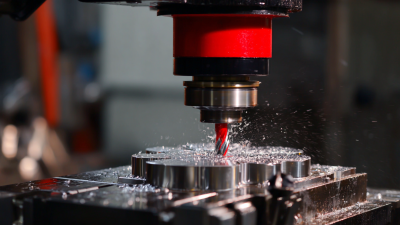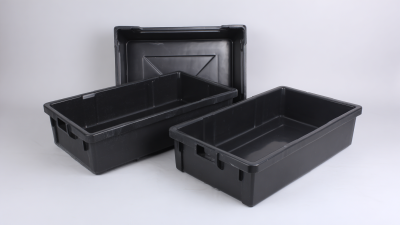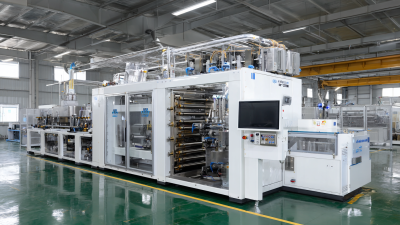How to Choose the Right Containment Tray for Your Industrial Needs
In today's industrial landscape, the importance of selecting the right containment tray cannot be overstated. According to a report by Grand View Research, the global spill containment market is projected to reach $3.2 billion by 2025, driven largely by stringent regulatory requirements and the increasing need for effective waste management solutions. With various options available, including plastic, metal, and composite materials, choosing the appropriate containment tray for your specific application is crucial for ensuring safety and compliance. A well-designed containment tray not only protects against spills and leaks but also enhances operational efficiency. This blog will explore key factors to consider when selecting the ideal containment tray tailored to meet your unique industrial needs, ensuring both functionality and adherence to industry standards.

Factors to Consider When Selecting a Containment Tray for Industrial Use
When selecting a containment tray for industrial use, it’s crucial to consider various factors that influence the tray’s performance and suitability for specific applications. One fundamental aspect is the material composition of the tray. According to industry reports, polyethylene and polypropylene are among the most common materials due to their chemical resistance and durability, making them ideal for storing hazardous liquids. Additionally, trays should be designed to handle significant weight and volume capacity. Research indicates that trays with reinforced edges and bases tend to withstand heavier loads, reducing the risk of spills and damage in industrial settings.

Another important consideration is the size and shape of the containment tray. Industries often face diverse operational demands, requiring various tray dimensions to fit specific equipment and placement areas. For instance, standard sizes can range from 24 inches by 30 inches to larger custom designs capable of accommodating bulk materials. Furthermore, the adaptability of trays to various applications—whether in food processing, pharmaceuticals, or manufacturing—is essential. A recent study highlighted that versatile design options improve facility efficiency, as they allow for seamless integration into existing workflows. By evaluating these factors, industrial operators can ensure they select the right containment tray that meets their operational needs while promoting safety and compliance.
Understanding Different Materials Used in Containment Trays
 When selecting a containment tray for industrial applications, understanding the materials used is crucial for ensuring both safety and efficiency. Common materials include polyethylene, steel, and aluminum, each offering distinct advantages. According to the American National Standards Institute (ANSI), polyethylene trays are highly resistant to corrosive substances, making them ideal for chemical containment. Their lightweight design also contributes to ease of transport and placement, allowing for flexible use in various environments.
When selecting a containment tray for industrial applications, understanding the materials used is crucial for ensuring both safety and efficiency. Common materials include polyethylene, steel, and aluminum, each offering distinct advantages. According to the American National Standards Institute (ANSI), polyethylene trays are highly resistant to corrosive substances, making them ideal for chemical containment. Their lightweight design also contributes to ease of transport and placement, allowing for flexible use in various environments.
Steel containment trays, on the other hand, are known for their durability and can withstand heavy loads, making them suitable for rigorous industrial settings. As reported by the Occupational Safety and Health Administration (OSHA), steel trays can also provide superior fire resistance, adding an extra layer of safety when dealing with flammable materials. For industries requiring a balance of weight and strength, aluminum trays offer a lightweight alternative without compromising on load-bearing capacity. Research indicates that aluminum’s resistance to oxidation enhances its longevity, making it an efficient choice for outdoor or harsh environments.
Understanding these material characteristics and their implications for safety and performance is essential for making an informed choice in containment solutions. Each option comes with its specific benefits tailored to different operational needs, ensuring that industrial facilities can maintain compliance and protect their workflow.
Sizing Guidelines: Choosing the Right Dimensions for Your Tray
When it comes to selecting the right containment tray for your industrial operations, one of the most critical factors to consider is the sizing. Ensuring that the dimensions of your tray match the requirements of your workspace and the materials being contained can prevent potential spills and accidents. According to the Environmental Protection Agency (EPA), improper sizing can lead to a lack of containment capacity, exposing businesses to fines and environmental hazards.
When measuring for a containment tray, it is essential to account for the maximum volume of liquids you expect to use. As a guideline, the tray should have a capacity that is at least 10% greater than the largest container of liquid that will be present. This not only provides adequate space for spills but also allows for safe handling and placement of multiple containers.
**Tips:** Always consider the potential for expansion in your operations. If you anticipate increases in storage or changes in liquid types, choosing a larger tray can save you time and costs in the long run. Additionally, utilizing trays with raised edges or built-in secondary containment features can enhance safety and compliance based on industry reports from the American National Standards Institute (ANSI).
How to Choose the Right Containment Tray for Your Industrial Needs - Sizing Guidelines: Choosing the Right Dimensions for Your Tray
| Tray Type | Dimensions (L x W x H in inches) | Capacity (Gallons) | Material | Best Use |
|---|---|---|---|---|
| Standard Tray | 48 x 34 x 6 | 50 | Polyethylene | Chemical spills |
| Heavy-Duty Tray | 60 x 48 x 8 | 100 | Steel | Large machinery |
| Drip Tray | 24 x 24 x 2 | 15 | Polypropylene | Workstation spills |
| Clearview Tray | 36 x 24 x 4 | 25 | Acrylic | Storage and easy inspection |
Essential Features to Look for in a High-Quality Containment Tray
When selecting a containment tray for your industrial needs, it's essential to consider several critical features that can enhance safety and efficiency in your operations. A high-quality containment tray should be made from durable materials that can withstand various chemicals and temperatures without deteriorating. Look for trays constructed from heavy-duty polyethylene or stainless steel, as these materials offer excellent resistance to corrosion and impact.
Another important feature is the capacity of the tray. Ensure that the tray you choose can accommodate the volume of materials you typically handle, considering any potential spills or leaks. It's also beneficial to opt for trays with built-in drainage systems, which facilitate easy cleanup and maintenance.
Tip: Always verify that the containment tray complies with industry regulations and standards, as this can prevent costly fines and improve your workplace safety protocol.
Lastly, consider the design and portability of the tray. A lightweight option with handles or wheels can simplify movement around your facility, making it easier to position the tray where it's most needed.
Tip: Investing in stackable trays can save valuable space when not in use while still providing the necessary containment capabilities.
Common Applications: Finding the Perfect Tray for Your Industry Needs
When selecting a containment tray for your industrial applications, it’s crucial to consider the specific needs of your industry. For instance, in the chemical manufacturing sector, trays constructed from high-density polyethylene (HDPE) or stainless steel are often preferred due to their resistance to corrosion and ability to withstand harsh chemicals. These materials help to maintain safety and prevent costly spills while ensuring compliance with environmental regulations.
In the automotive industry, containment trays must be designed to handle various fluids, such as oils and coolants. Trays that feature raised edges are ideal for this application, as they can prevent spills from spreading, thus keeping work areas clean and safe. Furthermore, lightweight modular trays allow for easy transport and reconfiguration in busy workshop environments, making them a practical choice for automotive maintenance and repair shops. By identifying the materials and features that best suit your specific application, you can ensure that you choose the perfect containment tray for your industrial needs.
Related Posts
-

5 Reasons Why CNC Machine Tooling is Essential for Modern Manufacturing
-

Unmatched Quality in Plastic Spill Trays from China Leading the Global Market
-

Innovative Chinese Manufacturing Elevates Global Sales of Top Thermoforming Vacuum Machines
-

Ultimate Guide to Choosing the Best Spill Tray for Chemicals Based on Your Needs
-

10 Essential Tips for Sourcing the Best Plastic Drip Tray for Your Business Needs
-

The Future of Sustainable Versatile Solutions with the Best Large Drip Pan in Global Markets